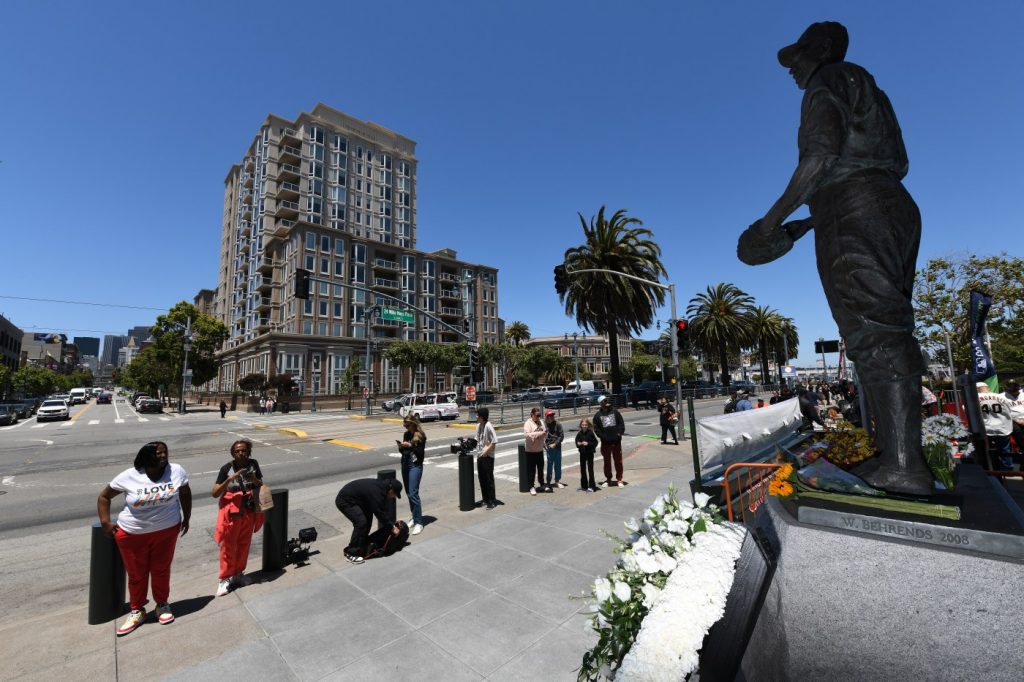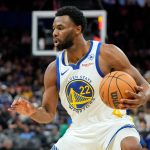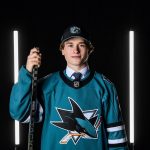SAN FRANCISCO — One block north of Willie Mays Plaza, where fans have paid their respects this week to one late Giants legend, a second bronze statue had morphed into a makeshift memorial by the time the gates of Oracle Park opened Saturday afternoon.
After learning Friday evening of Orlando Cepeda’s death at the age of 86, admirers of the pioneering Puerto Rican slugger, nicknamed “Baby Bull,” began to adorn his towering likeness at the corner of Second and King streets with bouquets of flowers, handwritten messages and photographs.
“What another gut punch,” manager Bob Melvin said. “To have it so close in proximity to Willie, it’s just kind of staggering.”
In the Giants’ dugout, they displayed Cepeda’s No. 30 jersey, and every player wore his name and number on a patch on the left sleeve of their jerseys. It was the only real estate available for the commemorative patch, with one honoring Mays already on the left chest of each jersey.
“It’s been a tough month for Giants baseball, losing special guys like that,” said starting pitcher Logan Webb, who was in the same position he was when he learned of Mays’ passing last Tuesday: on his way to take the mound for the beginning of the sixth inning.
An image of Cepeda appeared on the center field scoreboard, and the soldout crowd of 40,052 on hand for the opening game of the Giants’ series against the Dodgers responded with a moment of silence. Webb and many other players taking the field paused and removed their caps.
The emotions on the field paled in comparison to those three stories above them, in the Spanish-language radio booth where Cepeda was a regular visitor. Once roommates as two of Giants’ only Latin players, Cepeda would stop by Tito Fuentes’ booth three or four times a week, broadcasting partner Erwin Higueros said.
Informed about 30 minutes before the Giants publicly announced the news, Higueros had the sense to wait until they were off-air, then told Fuentes shortly before the rest of Oracle Park found out.
“I’ve never seen a man cry that much,” Higueros said. “They were like brothers. Like brothers. Orlando would still pick on Tito and Tito would not say anything back. It was that type of respect, even in their old age. It was a brotherhood type of relationship, so obviously yesterday, he took it really hard.”
When Fuentes received a midseason call-up to the Giants as a 21-year-old from Havana, Cuba, in 1965, he knew he had a strong ally in his corner. Already an eight-time All-Star, a Rookie of the Year winner and MVP finalist, Cepeda first met Fuentes while playing winter ball in Puerto Rico a year earlier and that spring advocated for him to make the roster, a recommendation that came to fruition a few months later.
Called up in August, Fuentes was assigned to bunk with Cepeda, who took him all over town in the start of a lifelong friendship. At a time when players were still discriminated against because of the color of their skin, Cepeda helped a young Fuentes overcome language and cultural barriers, too.
“The thing is, he couldn’t teach you how to hit. But off the field, how you had to conduct yourself,” Fuentes said. Cepeda showed him the restaurants that welcomed Black patrons — always picking up the check — introduced him to salsa music and taught him how to dress.
“At that time, Blacks and whites could not eat together,” Fuentes said. “So we had to go to Black restaurants that he knew. He usually paid, of course, because he was making money.”
Cepeda’s trailblazing ways didn’t end with his playing days, passing words of wisdom on to Higueros upon joining the Giants’ booth in 1998.
Make sure that you’re representing the Giants, don’t forget that, he told him. You’re representing us, the hispanic community. And you’re representing yourself. Whatever you do that is good is going to have an impact on all three, and if you do bad things it’s going to have a bad impact on us.
“That’s one of the things he told me and one of the things I still remember,” Higueros said.
Fuentes remembers the day Cepeda was traded to St. Louis — Mother’s Day, 1966 — he cried then, too.
“He embraced me and said, ‘Roomie, I’ve got to go. They traded me,’” Fuentes said.
The team needed to make room for another up-and-coming first baseman by the name of Willie McCovey, so they shipped Cepeda to the Cardinals in one of the more regrettable transactions in the franchise’s history. Before knee trouble derailed his career, Cepeda went on to win MVP for the Cardinals in 1967.
Related Articles
Wisely walks off Dodgers with SF Giants’ third home run of the game
SF Giants lose another legend: Orlando Cepeda dead at 86
SF Giants activate LaMonte Wade Jr. but lose 2 more players to injured list
Crucial series vs. Dodgers to test SF Giants’ stability, kick off grueling stretch
SF Giants denied four-game sweep of Cubs before Dodgers’ final visit
Cepeda’s career lasted another eight seasons, taking him from St. Louis to Atlanta to Oakland, Boston and Kansas City. But his legacy was always in San Francisco, where he became a community ambassador in retirement and where his statue has stood since 2008.
“Since he retired, he considered himself a Giant and was around here,” Melvin said. “Just such a great personality. I wasn’t around him as much as I was Willie, but I certainly know growing up and watching him play, the impact he had in San Francisco.”
Cepeda’s connection to San Francisco was never more evident than during his frequent visits with Fuentes.
“He would come into the booth and just talk baseball. He didn’t expect to be interviewed,” Higueros said. “He just wanted to come in and hang with his roomie. It was just a treat to hear them talk about the old days and joke around.”


